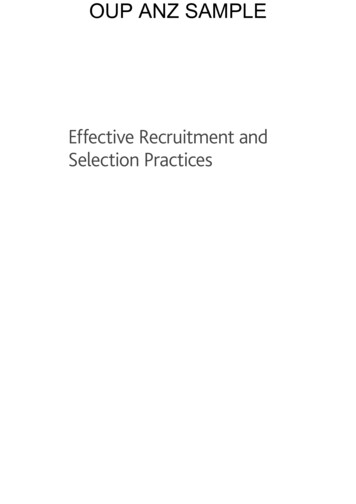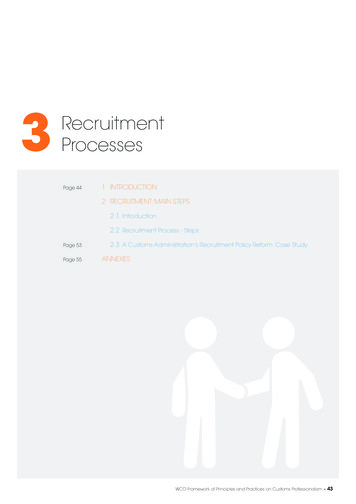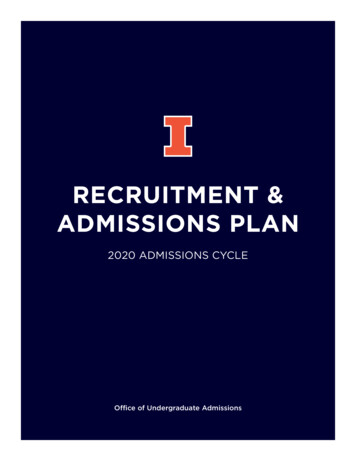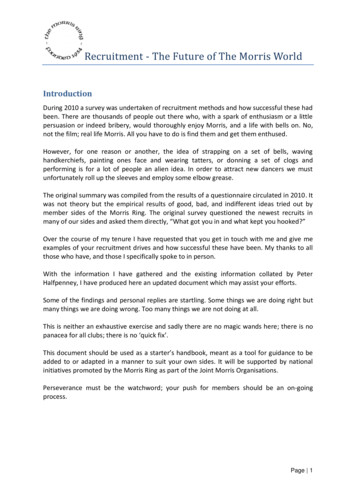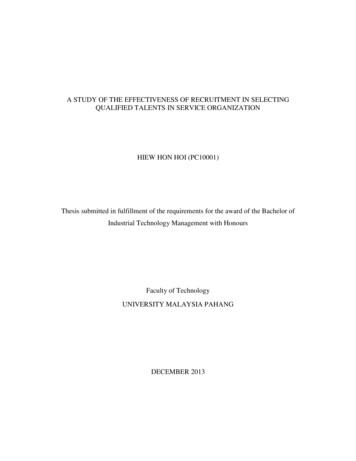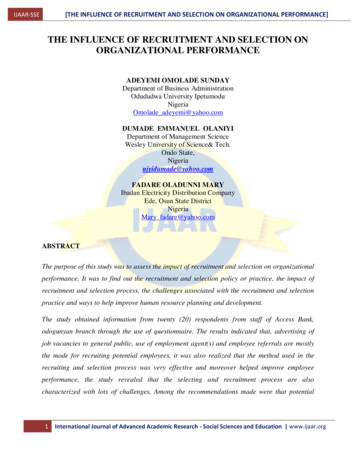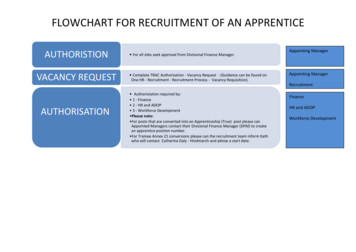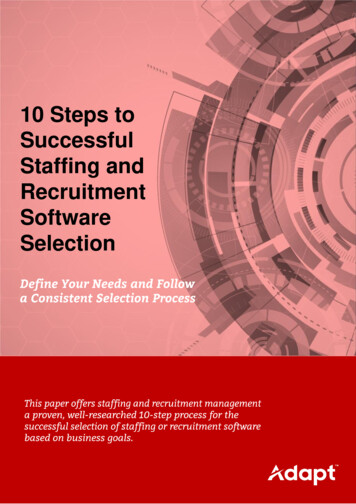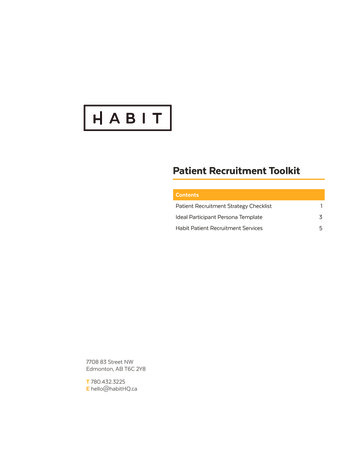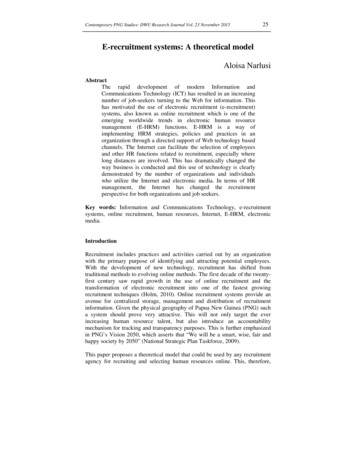
Transcription
Contemporary PNG Studies: DWU Research Journal Vol. 23 November 201525E-recruitment systems: A theoretical modelAloisa NarlusiAbstractThe rapid development of modern Information andCommunications Technology (ICT) has resulted in an increasingnumber of job-seekers turning to the Web for information. Thishas motivated the use of electronic recruitment (e-recruitment)systems, also known as online recruitment which is one of theemerging worldwide trends in electronic human resourcemanagement (E-HRM) functions. E-HRM is a way ofimplementing HRM strategies, policies and practices in anorganization through a directed support of Web technology basedchannels. The Internet can facilitate the selection of employeesand other HR functions related to recruitment, especially wherelong distances are involved. This has dramatically changed theway business is conducted and this use of technology is clearlydemonstrated by the number of organizations and individualswho utilize the Internet and electronic media. In terms of HRmanagement, the Internet has changed the recruitmentperspective for both organizations and job seekers.Key words: Information and Communications Technology, e-recruitmentsystems, online recruitment, human resources, Internet, E-HRM, electronicmedia.IntroductionRecruitment includes practices and activities carried out by an organizationwith the primary purpose of identifying and attracting potential employees.With the development of new technology, recruitment has shifted fromtraditional methods to evolving online methods. The first decade of the twentyfirst century saw rapid growth in the use of online recruitment and thetransformation of electronic recruitment into one of the fastest growingrecruitment techniques (Holm, 2010). Online recruitment systems provide anavenue for centralized storage, management and distribution of recruitmentinformation. Given the physical geography of Papua New Guinea (PNG) sucha system should prove very attractive. This will not only target the everincreasing human resource talent, but also introduce an accountabilitymechanism for tracking and transparency purposes. This is further emphasizedin PNG’s Vision 2050, which asserts that “We will be a smart, wise, fair andhappy society by 2050” (National Strategic Plan Taskforce, 2009).This paper proposes a theoretical model that could be used by any recruitmentagency for recruiting and selecting human resources online. This, therefore,
26 Narlusi, E-recruitment systems: A theoretical modelwould create a functional channel for recruitment agencies to communicatebetween job seekers and employers. It seeks to contribute to scholarlydiscussion on designing global recruiting services and systems, since sourcingnew staff is increasingly carried out on a global basis. Further, discussionsinclude a view to creating effective service delivery systems to support humancapital development through the use of technology and information systems.This theoretical innovation would enable access to a large base of potentialemployees. Ultimately, it should provide employers with the ability to recruiteven where great distances are involved.Literature reviewAccording to Fuertmueller (2012), e-recruitment is a diverse topic fed byvarious disciplines including Human Resources Management, OrganizationalBehaviour, Management, Information Technology and Computer Sciencefields. Because of this diversity, a comprehensive search for relevant journalarticles in human resource management and information systems was required.In recent years, there has been a large number of publications on e-recruitmentand the increasing diversity of publications on e-recruiting research calls for asynthesis (Wolswinkel, et al., 2010). The notion of an online recruitmentsystem is derived from literature surrounding the basis of e-HRM and functionsof a web-based channel for e-recruitment. This review integrates the various erecruitment findings and the possibility of developing a functional system thatruns online recruitment.Effectiveness of the theoretical system designAccording to Gopalia (2012), the effectiveness of e-HRM and selectionprocesses can be measured by several advantages. It saves time to hire whichcan usually be prolonged if using other news media. E-recruitment andselection procedures save costs of recruitment and administration, therebyreducing recruitment and administration cost. Furthermore, e-recruitment andselection provides a competitive edge to organizations by developing a marketimage and helps in terms of gaining advantage on the basis of speedy applicantdata collection. Finally, it allows access to a large verifiable talent pool ofcandidates, and focuses on expanding individual employment options as wellas improving recruitment processes for businesses.Theoretical e-recruitment systemThe proposed recruitment agency will function as a third party; it will form thelink between job seekers and employers. It will provide the interface by whichemployers can perform functions such as registering as a partner to the agency,viewing website contents, and uploading information about job vacancies andapplication forms.Job seekers will be able to use the Web interface to register and login to viewthe site, upload curriculum vitae (CV) and supporting documents for respective
Contemporary PNG Studies: DWU Research Journal Vol. 23 November 201527job vacancies, and receive notifications of job vacancies when they becomeavailable.Network designThe main objective of this paper is to provide an overview of the requirementsfor the effective performance of the network. Designing a network helps todiscover and establish a means of communication between two differentbranches of an organization or a global connectivity mechanism via a WideArea Network (WAN).Product contextThe aim is to design a WAN which will enable the system to interconnect andshare resources across large geographical distances. The finished product ismost likely to be a subsystem of other systems. It cannot be said to beindependent or self-contained because, with the use of Virtual PrivateNetworks (VPN), the system is contained within a broader public network. Alarger system can be built on this using two internal networks connectedtogether via an external interface such as the Internet.User characteristicsThe types and characteristics of the users who may come into contact with thesystem have been described in terms of certain general categories: power(advanced) users, who are job seekers as well, may be able to identify flaws inthe system design; average users who are just applicants in search of jobs;recent graduates who may have ample knowledge in this field of study may beable to criticize the product (Dhamija (2012).AssumptionsBecause having a design is most often based on anticipation of what isexpected, there are three main assumptions about the theoretical system. Thefirst is that the network design can only be feasible for Windows OperatingSystems. Secondly, the network documentation may be subjected to changewhen WAN media specified changes, or technologies used are upgraded.Finally, the WAN, operating over a VPN, is assumed to be able to handlerequests on a global scale.ConstraintsAccording to Lammle (2011), some items that might constrain a proposeddesign include parallel operation with an old system; access, management andsecurity; criticality of the hosted application; system resource constraints suchas limits on disk space or other hardware limitations, and other designconstraints including design or other standards, such as programming languageor framework.
28 Narlusi, E-recruitment systems: A theoretical modelDependenciesDependency requirements are the factors that the system depends on in order tofunction. In this case, several protocols are required since the WAN will beincorporating a VPN. Point-to-Point Tunnelling Protocol (PPTP) will be usedto facilitate encapsulation and encryption of data to be sent over a publicnetwork. It allows for data to be securely transferred from a remote to acorporate network. Secondly, Layer 2 Tunnelling Protocol (L2TP) will be usedto enable a device to use a dial-up connection to create a secure connection to acorporate network. It also incorporates the functions of PPTP. Moreover,Internet Protocol Security (IPSec), an industry-wide standard framework ofprotocols, is needed to allow for secure data transmission over an IP-basednetwork.Transmission Control Protocol / Internet Protocol (TCP/IP) takes large blocksof information from an application and breaks them into segments, it sequenceseach segment to enable reassembly. Then, using a routing table, it decides on abest route for the packet to take to its destination. Assuming the system runs ona Web platform, Hyper Text Transfer Protocol (HTTP) will be used to managecommunications between web browsers and web servers and open the rightresource when a link is being clicked, wherever that resource may actuallyreside. Finally, File Transfer Protocol (FTP) is needed to enable the system totransfer files. Users are still subject to an authentication login using passwordsand usernames implemented by system administrators.Security measures for the systemSecurity measures are factors that will protect the system from malicious oraccidental access, modification, disclosure, destruction or misuse. Somemeasures to be incorporated include encryption, activity logging, historical datasets, data integrity checks, and data encapsulation.Logical network designsThe system is designed to receive Internet connectivity through a leased linefrom an Internet Service Provider (ISP), which connects to the respectivecompany’s Local Area Network (LAN) via a Channel Service Unit / DataService Unit (CSU/ DSU) device (Figure 1).For security, there will be two firewall routers: one on the external interfacewhich will screen packets - objects transmitted on a network are divided intoparts called packets, which are given logical addresses so that they can berouted through an internetwork - coming through from the Internet, and one onthe internal interface which will screen packets that are being routed from theinternal network.
Contemporary PNG Studies: DWU Research Journal Vol. 23 November 201529Figure 1 Logical design of an in-house network that hosts the theoreticale-recruitment system.On the demilitarized zone (DMZ) interface, there will be the virtualized serverfarm, a group of virtual servers consolidated to operate on a single physicalserver, which will be accessible to both external and internal users. Because thenetwork will be used to host a Web application that is expected to be available24/7, the suggestion here is to have two Web servers.Just after the external firewall router will be the distribution layer pool ofswitches: one provides switching to access layer switches while the otherprovides load balancing between servers. There will also be an internal firewallrouter which connects to the access layer switch (Figure 1). To providesecurity, Virtual Local Area Networks (VLANs) can be used for the internalnetwork. Each VLAN provides connectivity and switching for respectiveorganizational departments. There will be wireless access points (WAP)connected to the access layer switch, to provide network access to wireless andmobile users.Database designAn essential requirement for designing a database is to identify the differentend-user requirements. Database requirements analysis seeks to gatherinformation needed to design a database that meets the informationalrequirements of a user or an organization. This includes the type of data that isto be stored in the database and the conditions under which that data needs tobe accessed. Database requirements analysis is often concerned with the natureand use of data. It involves the identification of the data elements which areneeded to support the data processing system of an organization, the placing ofthese elements into logical groups and the definition of the relationshipsbetween the groups. This theoretical model provides designs for a database thatwould capture information about candidates who have applied for advertisedpositions, employers who have advertised, and the available vacancies. Thisphase requires data, processing and management from the organization that
30 Narlusi, E-recruitment systems: A theoretical modeluses it. In this paper, simulated data will be used to illustrate a theoreticalstandard design.Purpose and needThe Recruitment Management Database would create a storage system for jobsand applicants who apply via a web portal. This storage system is designed tokeep records of job vacancies, the entities who advertise those jobs and thecandidates who have applied for vacancies. This would enable theestablishment of logical relationships between entities of the database andcapture it in the actual implementation.List of current data setsTable 1 A list of required entities and their respective attributes for the designof a database.CandidatesCandidate IDFirst nameSurnameGenderData of birthAgeMarital statusAddressEmailPhone numberCityStateCountryJob VacanciesJobIDPositionDescriptionLocationSalary packageBenefitsQualificationExperience requirementsApplications closing dateEmployersEmployer IDCompany nameCityStateCountryIndustryPostal addressEmailThe entity relationship model (Figure 2) illustrates how these data sets will becaptured and how the database will be structured.
Contemporary PNG Studies: DWU Research Journal Vol. 23 November 201531Figure 2 Entity relationship diagram illustrating the existence ofentities and attributes in the database, and the relationships that existbetween these entities. Rectangles represent the entities, which will beimplemented as tables in the database; ovals represent attributes,which are fields in the database; diamonds represent logicalrelationships between the entities involved; and ovals with doubleborders represent multi-valued attributes.According to the data requirements of the organization, the database presumesthere is a many-to-many relationship between candidates and job vacancies.This means that one candidate can apply for many jobs, and many candidatescan apply for the same (one) job. Further, there is a one-to-many relationshipbetween employers and job vacancies. At any one time, only one employer canadvertise a particular job. No two employers can advertise the same job.A many-to-many relationship in a relational database exists when one record intable A can be referenced by one or more records in table B and one record intable B can be referenced by one or more records in table A. This concept canbe captured by using a junction table to relate theoretical tables A and B whenphysically implementing the database.
32 Narlusi, E-recruitment systems: A theoretical modelFigure 3 The relational schema which transforms the entityrelationship diagram into an implementation model, thus indicatingprimary to foreign key relationships that would exist in the physicaltables when implemented.A relational schema transforms the high-level entity relationship model into animplementation model and shows how the database will be physicallyimplemented. It states primary to foreign key relations and maps data models.Figure 3 shows the relational schema with arrows pointing from the foreignkeys to their primary keys.Entities and data typesA list of entities, their respective fields and data types (Tables 2 to 6) areprovided for the physical database implementation. Note that because the webapplication allows for files to be uploaded (CV and references, etc.), there is aseparate directory storage for these files because some files might be too big tobe stored in Microsoft Access (which is the application used to simulate theexistence of a database system).
33Contemporary PNG Studies: DWU Research Journal Vol. 23 November 2015Table 2 CandidatesFieldCandidate IDFirst nameSurnameGenderDate of birthAgeMarital statusAddressEmailPhone TextTextTextTextTextTextTextTextTable 5 EmployersFieldEmployer IDCompany nameCityStateCountryIndustryPostal xtTable 3 ApplicationsFieldCandidate IDJob IDSubmission DateData TypeTextTextTextTable 4 Job VacanciesFieldData TypeJob y packageTextBenefitsTextQualificationTextExperience requirements TextApplicationsclosing TextdateTable 6 QualificationsFieldJob IDQualificationCandidate IDData TypeTextTextTextApplication developmentThe application component of the system uses the three-tier client-serverarchitecture (Figure 4). In this model, the client accesses the system via agraphical user interface (GUI) which is the website, the middle tier is theapplication or web server which processes requests and responses, and the thirdtier is the database management system (DBMS) for storage purposes.
34 Narlusi, E-recruitment systems: A theoretical modelFigure 4 Three-tier-client-server-model representing the systemarchitectureA typical Web request is sent to the Web server, which executes any ASP codeand translate them to HTML. If external data is required, a database request(SQL) is sent to the database server, which executes the SQL request and sendsthe data back to the Web server. The Web server collates and sends to the Webresponse to the client in HTML (Figure 5).Figure 5 Path taken by a typical web request and responseFunctionalitiesThe web application aims to achieve three main functions. These include,registering an applicant and an employer to log in to the site using theirallocated username and password and post jobs on the site, which are updatedin the database, thus, allowing applicants to apply for jobs and upload relateddocuments to be saved in a directory on the site.
Contemporary PNG Studies: DWU Research Journal Vol. 23 November 201535The system is developed in such a way that, when viewing the database, onecan identify which employers posted which jobs, and how many jobs altogetherwere posted by which employer. Furthermore, it indicates which candidateapplied for a job, using what qualification, and on what date so that recruitmentofficers know that they have not passed the applications closing date.Because some information on the web site is private and confidential, ASPsession objects can be used to ensure that only registered members are able tolog in and view the page content. Unregistered users would not be able to viewcertain pages and will be redirected to the login page. To be able to login, youmust first register. Hence, this measure limits access to registered users only.ConclusionThis paper has discussed the design of a theoretical model for an onlinerecruitment system, which would be hosted on a proposed network design andusing a simulated database system. It would enhance global recruitmentactivities. E-recruitment is a phenomenon that has led to the appearance of anew market in which there is an unprecedented level of interaction betweenemployers and potential employees. A vast volume of literature continues tobecome available from the perspective of Human Resources Management(HRM), Information Technology (IT) and other disciplines.The implementation of an e-recruitment system with full functionality dependsentirely on the organizational and informational needs of those concerned. Onesuch system is the theoretical online recruitment model which this paper hasdiscussed. This model enhances flexibility of recruitment by ensuring amechanism is provided for accountability, tracking and transparency. Valuableinformation can, therefore, be centrally stored and distributed so as to avoiddata redundancy and duplication. Limits of physical mobility, which may haveprevented online recruitment in the past, are removed by ‘cyber-mobility’.Regardless of where they live, individuals as much as organizations can have aglobal presence, working in virtual teams anywhere in the world.AcknowledgementsI acknowledge Mr Martin Daniel, lecturer in the Information SystemsDepartment, for his contribution of ideas in this paper. Special thanks also toProfessor Peter Anderson, Head of the Information Systems Department, forassistance with editing and revision. However, responsibility for any remainingerrors of fact or opinion remains with the author.ReferencesDhamija, P. (2012). E-Recruitment : A road map towards e-human resourcemanagement. Journal of Arts, Science and Commerce, 33-39.Furtmueller, E. (2012). Using Technology for Global Recruitment. Netherlands:Dissertation to obtain the degree of doctor at the University of Twente.Gopalia, A. (2012). Effectiveness of Online Recruitment and Selection Process: A Caseof Tesco. Oxford City, England: Oxford Brookes University.
36 Narlusi, E-recruitment systems: A theoretical modelHarman, C., & Brelade, S. (2007, June 26-29). Managing Human Resources in theKnowledge Economy. United Nations 7th Global Forum on Re-inventingGovernment, pp. 1-8.Holm, A. B. (2010). The Effect of E-recruitment on the Recruitment Process : Evidencefrom Case Studies of Three Danish MNCs. Third European Academic Workshopon electronic Human Resource Management (pp. 91-111). Bamberg, Germany:CEUR-WS.org.Lammle, T. (2011). Cisco Certified Network Associate STUDY GUIDE, SeventhEdition. Indianapolis, Indiana: Wiley Publishing, Inc.National Strategic Plan Taskforce. (2009). Papua New Guinea Vision 2050. PortMoresby.Pin , J. R., Laorden, M., & Saenz-Diez, I. (2001). Internet Recruiting Power:Opportunities and Effectiveness. Barcelona, Spain: International Research Centreon Organizations (IRCO).Wolswinkel, J., Fuertmueller, E., & Wilderom, C. (2010). Reflecting on E-RecruitingResearch Using Grounded Theory. 18th European Conference on InformationSystems (pp. 1-12). Netherlands: University of Twente.AuthorAloisa Narlusi is a DWU graduate and Gold Medalist employed as a TeachingFellow in the Department of Information Systems. She holds a Bachelor ofInformation Systems degree and a Postgraduate Certificate in Higher EducationTeaching and Learning. This paper has its origins in her final year projectwhich was presented at the 8th Annual Information Systems Symposium atDWU in 2013. Aloisa is also a certified CCNA 1 and 2 instructor and herinterests include research on changing technologies and the impact these haveon certain educational, business and economic scenarios.Email: anarlusi@dwu.ac.pgGlossaryASPActive Server PagesCSU/ DSU Channel Service Unit /Data Service UnitCVCurriculum VitaeDBMSDatabaseManagementSystemDHCPDynamic Host ControlProtocolDMZDemilitarized ZoneDNSDomain Name SystemE-HRMElectronicHumanResource ManagementEREntity RelationshipFTPFile Transfer ProtocolGUIGraphical User InterfaceHRHuman hnologyIPSecISPL2TPLANMSPNGPPTPSQLTCP/ IPVLANVOIPVPNWANWAPInternet Protocol SecurityInternet Service ProviderLayer2TunnellingProtocolLocal Area NetworkMicrosoftPapua New GuineaPoint-to-Point ionControlProtocol / Internet otocolVirtual Private NetworkingWide Area NetworkWireless Access Points
30 Narlusi, E-recruitment systems: A theoretical model uses it. In this paper, simulated data will be used to illustrate a theoretical standard design. Purpose and need The Recruitment Management Database would create a storage system for jobs
